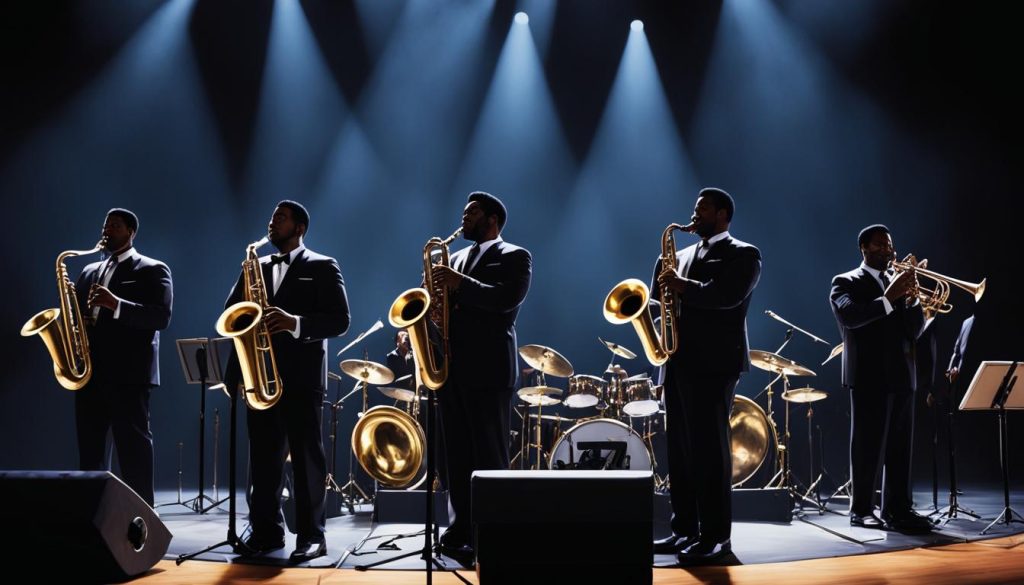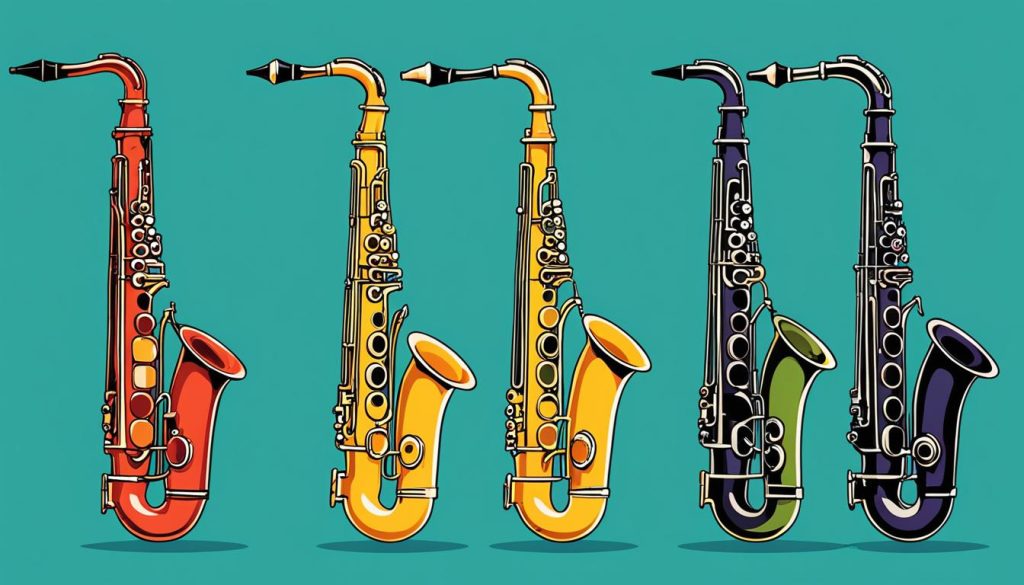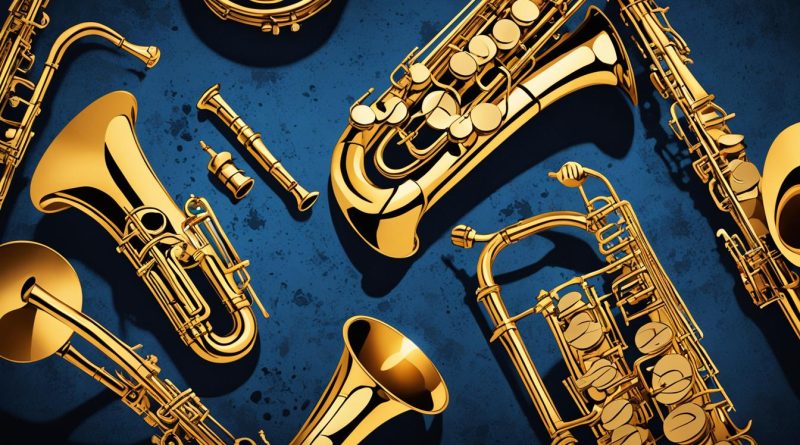Essential Jazz Instruments for Enthusiasts
Jazz music is renowned for its soulful sound and improvisational nature, which can be attributed to the unique blend of instruments that comprise this genre. Jazz instruments are essential to creating the sound that captures the hearts of enthusiasts worldwide. From the colorful brass instruments to the expressive woodwinds and the driving rhythms of the percussion, jazz music is a symphony of beautiful instruments that come together to create a vibrant sound.
Key Takeaways
- Jazz music is defined by its unique blend of instruments.
- Essential jazz instruments include brass, woodwind, and percussion.
- Each instrument plays a crucial role in creating the dynamic nature of jazz music.
- Jazz music is renowned for its soulful sound and improvisational nature.
- Understanding the essential jazz instruments and their contributions is key to unlocking the secrets of this extraordinary genre.
Key Brass Instruments in Jazz
In jazz, brass instruments bring to life a sound that is both lively and soulful. These instruments are characterized by their sound production, which is made by buzzing into a mouthpiece while using the musician’s lips and facial muscles to alter the sound. Some of the essential brass instruments in jazz music are:
| Instrument | Characteristics | Notable Musicians |
|---|---|---|
| Trumpet | The lively, brash sound of the trumpet is a hallmark of jazz music. It’s the highest-pitched member of the brass family and has a bright, clear sound. The use of mutes can change the timbre of the trumpet, allowing for different moods and tones. | Louis Armstrong, Dizzy Gillespie, Miles Davis. |
| Trombone | The trombone is a versatile instrument that can produce smooth, sustained tones as well as abrupt, staccato sounds that add a punch to jazz music. It’s often used to create harmony, as well as solos and melodic lines. The use of a slide allows for continuous and smooth changes in pitch. | JJ Johnson, Kid Ory, Wycliffe Gordon |
| French Horn | The French Horn has a mellow tone that adds a unique warmth and rich texture to jazz music. It’s highly versatile and has a range that can produce a wide variety of sounds and effects. | John Clark, Vincent Chancey, Tom Varner |
There are also other types of brass instruments used in jazz, such as the tuba and the cornet, which add a unique character and depth to jazz music.
Fun fact: Jazz music originated in the late 19th and early 20th centuries, primarily in African American communities. New Orleans is considered the birthplace of jazz, and brass bands played a significant role in the development and evolution of this popular genre.

Essential Woodwind Instruments in Jazz
From the smoky tones of the tenor saxophone to the playful improvisations of the clarinet, woodwind instruments play a vital role in shaping the dynamic nature of jazz music.
The saxophone is one of the most popular woodwind instruments in jazz. Its rich, resonant sound makes it an indispensable element in creating the soulful vibe that characterizes this genre. The tenor sax, in particular, is known for its versatility and the ability to blend seamlessly with other instruments in an ensemble.
The clarinet is another essential woodwind instrument in jazz. With its warm and expressive tone, the clarinet is perfect for both melodic solos and intricate harmonies. Professional jazz musicians often prefer the clarinet because of its ability to produce different dynamic levels, ranging from mellow to intense, which adds variety to any jazz performance.
Other woodwind instruments used in jazz include the flute, piccolo, and bassoon. While not as widely used as the saxophone or clarinet, these instruments offer a unique sound that adds depth and texture to jazz music.

“The saxophone is capable of great expression, joy, and sadness. It can coax the music along like a vocalist, or skate deftly through complex changes like a pianist’s fingers.” – Michael Brecker
The Rhythmic Backbone: Percussion in Jazz
While the brass and woodwind instruments are often the center of attention in jazz music, the role of the percussion instruments cannot be overlooked. In fact, they provide the rhythmic backbone that drives jazz performances forward.
The most essential percussion instrument in jazz music is undoubtedly the drum set. Consisting of a bass drum, snare drum, and various cymbals, the drum set provides the driving beat that sets the tempo and propels the music forward. Skilled jazz drummers like Max Roach and Art Blakey are known for their virtuosic performances, using the drum set to create complex rhythms and intricate patterns that complement the melodies and harmonies of the other instruments.
Other important percussion instruments in jazz music include the vibraphone, maracas, and congas. The vibraphone, also known as the vibes, is a keyboard percussion instrument that creates a shimmering, ethereal sound. Jazz legends like Lionel Hampton and Milt Jackson are known for their masterful use of the vibes in their performances. The maracas and congas, on the other hand, provide the distinctive Latin and Caribbean rhythms that have become a hallmark of jazz music.
“Jazz is the type of music that can absorb so many things and still be jazz.” – Sonny Rollins
In conclusion, while the brass and woodwind instruments may steal the show in jazz performances, the percussion instruments play an indispensable role in creating the genre’s unique sound. From the driving beat of the drum set to the shimmering tones of the vibes and the exotic rhythms of the maracas and congas, percussion instruments provide the energy and foundation that keep jazz performances moving forward.
Conclusion
In summary, jazz music is a genre that has been shaped by a diverse range of instruments, each playing a crucial role in its development and evolution. The vibrant brass instruments, expressive woodwinds, and rhythmic percussion instruments all work together to create an unmistakable sound that captivates audiences.
Understanding the essential jazz instruments and their contributions is crucial for aspiring jazz musicians who want to unlock the secrets of this extraordinary genre and delve deeper into its rich heritage. By mastering the nuances of each instrument, musicians can create their unique voice and contribute to the ongoing evolution of jazz music.
From the early days of the genre to the present, jazz music has been an ever-changing landscape of creativity, innovation, and artistry. Its unique sound and rich history make it a genre that continues to inspire and captivate enthusiasts and musicians alike.
Whether it’s the swinging rhythms of the drums, the wailing melodies of the saxophone, or the explosive energy of the trumpet, jazz instruments come together to create an experience like no other.
In conclusion, jazz music is a genre that has stood the test of time and continues to be a source of inspiration and wonder for generations to come.
FAQ
What are the essential jazz instruments?
The essential jazz instruments include brass instruments, woodwind instruments, and percussion instruments. These instruments come together to create the distinctive sound of jazz music.
Which brass instruments are key in jazz music?
Key brass instruments in jazz include the trumpet, trombone, and saxophone. These instruments are known for their vibrant tones and ability to lead melodic lines or provide powerful solos in jazz performances.
What are the essential woodwind instruments in jazz?
The essential woodwind instruments in jazz include the saxophone, clarinet, and flute. These instruments add depth, texture, and improvisational possibilities to jazz music.
Why are percussion instruments important in jazz?
Percussion instruments provide the rhythmic backbone of jazz music. Drums, cymbals, and other percussion instruments drive the beat, add accents, and create energy in jazz performances.
How do these instruments contribute to the overall sound of jazz?
Jazz instruments work together to create the rich and dynamic sound of the genre. The brass instruments provide vibrant melodies and solos, woodwind instruments add texture and improvisation, and percussion instruments establish the rhythmic foundation. Together, they create the unmistakable sound of jazz music.
